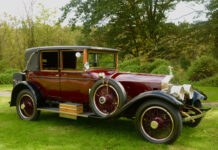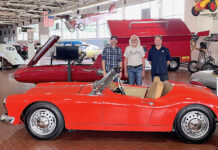By Jay Hirsch
The Hudson Jet was a “compact” or downsized car that was made by the Hudson Motor Car Company in 1953 and 1954. The Jet was Hudson’s response to the popular Nash Rambler. Where the standard Hudson was either 202 inches or 208 inches in length, the Jet was only 180 inch. Weighing in at 2,700 pounds it was about 1,000 pounds lighter than the Hudson.
The Jetliner, with its small inline 202 cid/3.3-liter, 6-cylinder engine, had no problem getting 20 to 25 mpg. As with many 1954 cars, the Jetliner was six-volt. By 1956 all American made cars would be 12 volt.
The Jet was not just a small car. It is a small car with the interior room of a full-sized car. The trunk had ample room for luggage and a few golf bags. With the spare tire mounted on the rear bumper there is exceptional luggage space, equal to cars being 20 inches longer.
Being a Hudson, the Jet has the famed “step down design” that Hudson introduced in 1948. It would be another 10 years until American cars would utilize this design. When entering the vehicle you step down onto the floor. It is lower than the door still, which enables the car’s center of gravity to be lower for much better handling and ride.
Hudson President Abraham Edward Barit (or A.E. Barit, as he liked to be called) disregarded some of the company’s designers by insisting the Jet have chair high seats and a high ceiling to allow men to wear hats while in the car. This was at the time when the Big Three were beginning to design cars which were more streamlined and lower. The designers wanted to make a car that was lower, wider, and sleeker, but Barit would not back down on the tall greenhouse and chair high seats. Barit also liked the round tail lights on the Oldsmobile and had this look incorporated onto the Jet. The Jet’s unitized body was made by the Murray Corporation in Detroit.
With its two-tone paint schemes, the Jet, Super Jet, and the top of the line in 1954 Jetliner did not appear to be cheap little cars. The problem with selling the Jet as with the Hudson and other independent car manufacturers was distribution.
The Big Three — Chrysler, Ford and General Motors — had many more dealerships, and they kept them tied up with only selling their Big Three product.
Unlike today, where a car dealership may sell a Chevrolet and in an adjoining showroom have a Toyota, BMW, Jeep, etc., in the 1950s and earlier a car dealer would have one or two models. If the dealership did have more than one model it had to be from the same company.
When the Jet came onto the car world in 1953 it was only offered as a four-door sedan. In mid-year the two-door was added, and in 1954, in addition to the base Jet and Super Jet, the Jetliner was added. The Jetliner had every convenience and option available at the time for a Jet.
Standard equipment included a heater and defroster, theft proof locks, full wheel covers and a lighted ignition switch. Front seat-backs had back pockets, there were robe cords for the hanging of clothing, courtesy door lights, automatic dome light with manual switch, front and rear ash tray, and cigar lighter — not only did people smoke but men smoked cigars inside a car!
The center mounted roof antenna was manually operated. With a turn of a knob, mounted just above the windshield on the interior of the car, one could twist the antenna down into the center of the windshield, out of harms way for car washes or low clearances.
The front hood scoop, while giving the car a racy look of power, was pure ornamentation. But it does look good nonetheless. The Jetliner seen here has been in the same family since new. The owner’s father was a Hudson dealer, and when Hudson and Nash merged to become American Motors, he became an AMC dealer and in the 1980s a Jeep dealer.
The Jetliner handles and rides more like a mid-1960s car than an early 1953, which really translates into a pre-WWII type of ride and handling for most cars of this era. There is a minimal swing and sway with the Jetliner, which in no small part is due its compact size. The chair high seats, while contributing to the boxy look of the Jet, also make for very comfortable sitting. Your legs hang down, as when sitting in an arm chair or “Captains Chair” as in many SUVs of today. Your legs are not stretched out flat on the floor.
In 1955 Hudson joined Nash and the two became American Motors. Nash was the more powerful or profitable of the two, and some things had to change. The first of those was the dropping of the Jet in 1955. The Hudson itself was a Hudson by name only. It was a Nash with different trim and slight body modifications, and 1957 would see the last time the name Hudson would appear on a car
The Jetliner has a 105-inch wheelbase is 60.875 inches tall, rides on 6.40 x 15 tires, and sold for $1,933. In 1954, 14,224 Jets were sold of all models.
This Jetliner, except for a repaint in its original red with creamy-white roof, is all original and has been with the same family since 1953. Dick Zuidema’s father, being a dealer, always used a “demo” for daily use. Being a car lover, every year he put away one or two cars that “were special.” Among some of those special cars, in addition to the Jet, are a 1948 Hudson convertible, a 1952 Hudson Hollywood, a 1954 Hudson convertible, and a 1954 Hudson Hollywood coupe.
In 1954 ad copy for the Jet, Hudson refers to the Jet as a “compact car” and not a small car. Hudson was on the cusp of a new generation of cars, only a decade too soon: “New 1954 Hudson Super Jet This compact new kind of car brings Hornet like performance luxury and safety to the lowest price field.” •



